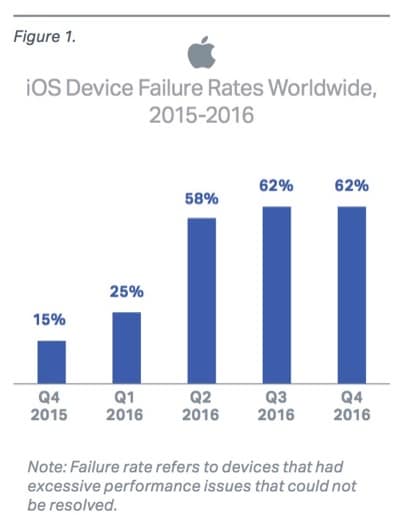Recently, Blancco published a report on the performance and health of iPhones and Android smartphones. “The State of Mobile Device Performance and Health: Q4 2016.” It created quite a stir at first.

A key finding was that iPhones are less reliable than Android devices. The report intrigued me, so I asked for a copy of the report and looked into the findings. Here’s what I found.
The first thing I wanted to know about was the background of Blancco, a company I’d never heard of. I found this at Reuters.
Blancco Technology Group Plc, formerly Regenersis Plc, is a provider of mobile device diagnostics and secure data erasure solutions. The Company’s segments include Erasure and Diagnostics…. The Diagnostic segment includes Xcaliber Technologies, a smartphone diagnostics software business.
Defining Terms
Having looked into the company for background, I next looked at the 19 page report they kindly sent. A term that popped right out was the use of the phrase “failure rate.” When I heard that term, the notion of a hardware failure only was on my mind. In fact, however, Blancco defines the term in a more general way.
Failure rate refers to devices that had excessive performance issues that could not be resolved.
This refers to some unintended behavior that the customer could not fix on their own. It could be a headphone jack that acted up, a rapidly dissipating battery or even an app crash. We don’t normally think of a crash by an app as Apple’s bailiwick, but in this case it’s a whole system approach.
On this basis, the reports starts out with its first finding.
Our data suggests that it’s more reliable to own Android devices than iPhones, which have been weighed down by a multitude of performance issues and high failure rates in the last year. Although iOS devices haven’t always had a higher failure rate than their Android counterparts, the failure rate has steadily increased quarter over quarter for the last year until it finally stabilized in Q4 2016.
Right away, I wanted to know more about “our data.” Was it a survey? Was it a random sampling of the hardware? I asked Blancco about that. They responded.
The information contained in this report is based on internal data collected from millions of iOS and Android mobile devices that were brought into mobile carriers and device manufacturers for diagnostics testing in North America, Europe and Asia over the course of five quarters, including Q4 2015, Q1 2016, Q2 2016, Q3 2016 and Q4 2016. The diagnostics tests were performed using the Blancco Mobile Diagnostics platform.
So then my next question was this: This report looks only at units that were brought into carriers and manufacturers for failure analysis, remembering that failure could mean that, say, the Facebook app that continued to crash.
Apple sells more than 200 million iPhones each year these days. So even if several million iPhones were analyzed, that represents only about a percent of the annual sales and much less for the installed base. The other, perhaps, 99 percent didn’t have issues. Or didn’t complain.
With all the above in mind, we can better undestand the first chart, Figure 1, and understand the large numbers presented.

The report explains:
In Q4 2015, for example, iOS devices had an overall failure rate of 15 percent. This was considerably lower than Android devices, which had an 85 percent failure rate during that period. But as each quarter has passed, the iOS failure rate has increased steadily – from 15 percent in Q4 2015 to 25 percent in Q1 2016 to 58 percent in Q2 2016 to 62 percent in Q3 2016. Now in Q4 2016, iOS devices once again lost the performance battle with more performance issues and higher failure rates worldwide (62 percent) than Android devices (47 percent).
The iPhone 6 is singled out as one model that experienced more performance failures than other models.
One possible explanation for why the iPhone 6 may have struggled with more performance issues and failures than other models over the last year could be Apple’s release of multiple software updates – iOS 9.3.1 in April 2016, iOS 9.3.2 in May 2016, iOS 10 in September 2016 and iOS 10.2 in December 2016. Following all of these software updates, many iPhone and iPad users began to experience problems on their devices, such as faster battery drain, ‘bricking,’ random crashes, poor sound quality when taking Bluetooth calls, crashing apps and WiFi connectivity problems, just to name a few.
Next page: Perspectives & the Good News

When looking at data like this it must be kept in mind whether there are special circumstances that could have caused deviations in each group, and how those deviations were treated in the analysis. For example, Apple and Samsung both had battery extended warranty/ recall events recently. In Apple’s case they replaced the battery in customer’s phones, which I’m sure was treated as “an issue customers could not fix themselves” by the survey. In Samsung’s case they were forced to pull the phones off the market and refund people’s money. It is unclear how the survey would have handled that. We do know that the Samsung recall involved a lot of phones, so Having the Android reliability statistics go up during that period suggests the incident was excluded.
Also, in Apple’s case I’m sure a lot of phones on the battery replacement program list were working to the customer’s satisfaction were only brought in for “preventative maintenance” to avoid potential future issues (I know that was true in my case).
Not surprisingly, exclusion from the analysis of a large forced safety recall for one platform and inclusion of encouraged preventative maintenance for the other platform would severely skew the results, invalidating any conclusions.